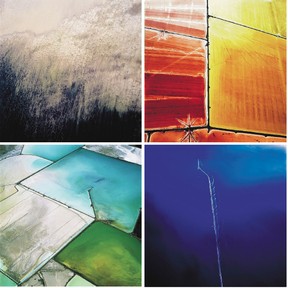Wait a Minute Didnt I See This Comic Before in Your Art Gallery
The Fine art of of Influence: Marianne Apostolides on David Maisel's photography
At beginning, David Maisel'south images felt like abstractions; and then, they opened a door in Marianne Apostolides, inspiring a new direction for her near recent novel.
Reviews and recommendations are unbiased and products are independently selected. Postmedia may earn an chapter commission from purchases made through links on this folio.

When I'chiliad stuck in my writing, I'll hop on my cycle and pedal furiously, rocketing by streetcars to swerve onto side roads that take me to an art gallery.
I open the doors. The sound is tremendously silent.
It's no wonder, then, that my latest book, Sophrosyne, includes a chapter set at an art exhibit.
The novel follows a seriously screwed up 21-yr-old student named Alex. He's a philosophy major who's decided to write his thesis on 'sophrosyne,' a seminal Socratic virtue that's frequently (inadequately) translated as 'self-command.' Alex's thoughts pulse with urgency, his research driven by loss and longing — namely, by his need to understand his relationship to his seductive mother, a belly-dancer whose stage name is Sophrosyne.
In this mode, personal motive and abstract ideas swirl within each other, given expression through language that's idiosyncratic and oddly rhythmic. I wanted Sophrosyne to return ideas equally bodies, equally desire, contained within characters. I'd utilize the allure of language to lead the reader toward pressing questions: How do we define ourselves in a radically altered world — one in which God is absent, technology is omnipresent, and the global environs is in collapse? And how can 'self-restraint' aid us empathise ourselves, let alone the broader social forces around us?
No wonder I was having trouble….
After months of writing thousands and thousands of useless words —grains of sand I pushed beyond the page — I got on my bicycle and I went to an fine art gallery.
Sometimes the respond is staring us right in the centre. As well bad we demand to torture ourselves earlier we can encounter it.
When I got off my bike that October 24-hour interval, ii years ago now, I saw my answer: Alex needed to attend a museum, where he'd meet a adult female. Specifically, they'd meet while immersed in the haunting, luscious images of contemporary photographer David Maisel.
Maisel represents a trend in the art world, away from postmodernism toward an encompass of the 'terrible sublime.' Based in Fifty.A., he's created a body of work that's varied in subject, though all his photos seem to question the pregnant of humanity in relation to nature, technology, history, 'progress.'
At outset, Maisel'south images feel like abstractions; I approach their colours and contours, unsure of the object that Maisel has captured. Certainly, these photos portray a affair — an object existent in reality — just what I see is a saturation of awareness, a richness that seems almost geographic.
Which is exactly what it is.
In several series, Maisel takes photos from airplanes, depicting a unique perspective on globe: its toxic tailings ponds, clear-cutting forests, open-pit mines. He shows a mural scarred by flesh'due south technological prowess — our mastery over nature — fifty-fifty equally we fail to control our human being appetites.
Nosotros've heard this theme chimed many times in contempo years. We've heard information technology then much, in fact, that we don't know how to receive it.
And that's the power of Maisel's work: he portrays our contemporary horror, merely he does so with a swell attunement to beauty. His photos are not didactic or ironic; instead, Maisel creates a space where we can stand up, in stillness, and absorb the thrumming significance of his images. Nosotros demand this beauty to soothe the states — not to numb usa to the reality around us, but to act as a balm that calms the ever-present buzz of stimuli, the electrical data that frazzles our thoughts, demanding a reaction, urging us out of ourselves and our serenity reflection on our response to the world outside.
Through Maisel, I was able to button forward with my novel. Inside the sensually heightened infinite of the gallery, Maisel's artwork created a medium where my characters could finally connect. My language could exist descriptive — the dark-green of a photo, her hand in her pilus — just likewise extend to the noumenal the realm. With his lens, Maisel asks vibrant, vital questions virtually the human condition in our era; through my words, I offer a response: "the photo depicts a mine in Nevada. An aerial photo of minerals pooling. And the colours are coursing, budgeted the dark-green. Because they outline, internal, like the veins on a leaf or the roots of a tree, and they're filling with sweet. Sugars, or claret, and they're breathing."
I'yard back at my desk at present, pen in hand. I'm thankful for artists like Maisel, for Toronto's many galleries, for the ongoing, ever-irresolute conversation to which I might add together my small voice.
* * *
Marianne Apostolides is the author of v books, which have been translated into three languages. Her virtually recent book is Sophrosyne (BookThug). For more information, see marianne-apostolides.com. For more information on the work of David Maisel, see davidmaisel.com.
Source: https://nationalpost.com/entertainment/books/the-art-of-of-influence-marianne-apostolides
